| |
Glenwood Cemetery was founded and erected in
1863. It contains some of the most prominent people from the Lockport area
and still it keeps growing. The cemetery I believe gives tours to some of
the more well known monuments and the even the caretaker lives on the
property. This has has to be one of the nice cemeteries in all of western
NY. Not that it contains as many famous monuments such as Forest Lawn
Cemetery but it is very pretty with very high rolling hills, train tracks
running through the back, many large evergreen trees, and woods
surrounding the entire area of this 60 plus acre cemetery. Is it eerie at
night? Easily as you can walk onto its dark trails, up a wood hill or even
get lost in 1000s of beautiful stones.
I wanted to complete this place before I moved
since it is more well known. Surprisingly we had 8 investigators for this
place so I split the group up and what Ryan and I did was cover all the
historical areas here while the other group focuses on ghost and strange
things. Of course equally we produced good results. Is it haunted? Definitely
there are ghost here, feelings of being watched, cold spots, and even
occasionally a moving shadow or apparition that can be seen if you are
focused enough. Approaching the large granite ornate arched gates is
enough to make you think twice but this place really is nice day or night
to visit.
There are many stories that go with the stones
or rather some of the more prominent people. I will try and cover a few
things about them below which you can read on written by John Hodge and
the town of Lockport site. Although to some it will not matter as much as
the ghostly photos taken here but to our group this is why we chose to do
an investigation here was to try and catch some of the more well known
Lockport residents on film and give you a story to go with the
photos.
© By
Rick-AngelOfThyNight
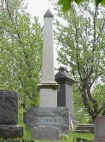
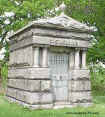
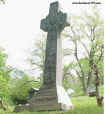
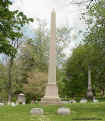

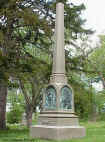



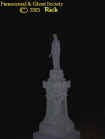
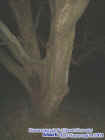
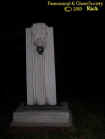










Governor Washington Hunt
The New York governor and Lockport lawyer is perhaps the most famous resident here.
Hunt came to Lockport from Vermont in 1828, first working as a clerk and then studying law. He was admitted to the bar in 1834 but never gained much fame or fortune from his practice.
Most of Hunt's money came from a partnership he formed with his well-to-do father-in-law, Henry Walbridge. They bought up the remaining land in this area from the Holland Land Company, about 32,000 acres, and re-sold it in smaller parcels.
First active in the Democratic Party, he served as a Niagara County Judge for five years. He then switched to the Whig Party and ran for, and was elected to, Congress in 1842, serving three terms. Later he was first appointed, then elected, New York State Comptroller.
He then ran (as a Whig) for New York Governor and was elected (by only a 262 vote margin) in 1850 for a two year term. The significant accomplishment of his term was to advocate for and sign legislation for the Erie Barge Canal. He was defeated for a second term as governor and returned to Lockport to make money in land dealings.
Hunt had a residence and office off Market Street in Lowertown and but his famous mansion and estate was at Wyndham Lawn, on the northern border of Lockport. The spacious Wyndham property has been lost to public appreciation, having been turned into a home for wayward boys and girls. The former Hunt law office has been moved to the campus of the Niagara County Historical Society where it is open for public viewing. Washington Hunt, learning he was near death, spent his final months in New York City under hospital care in an attempt to deal with cancer. One of Lockport's public elementary schools is named after him.
John Hodge Memorial
The Hodge monument is one of the tallest found in cemeteries in the state.
John Hodge came to Lockport at age ten and turned out to be one of the most prominent Lockportians of the last half the 19th century.
Most of his money came from his involvement in the Lockport Merchant's Gargling Oil Company which he eventually became sole manager of. He is the third Lockportain who made a fortune selling the dubious "medicine" to thousands across the United States.
One of his results of his money was the once prestigious Hodge Opera House which burned down twice (where Bewley Building is today).
His will left instructions to his widow to fund the building of the stone archway at the entry to Glenwood Cemetery. This archway was made from a single block of granite.
Outwater Memorial
The Outwater family of Lockport traces roots back to Holland from where early Lockport settlers came by way of New Jersey. The Outwaters are a true pioneer Lockport family and these early residents were involved in a number of occupations and locations around Niagara County.
The most famous and generous of the Outwaters was Dr. Samuel Outwater who practiced medicine here. After retiring from practice he moved to the Oakland, CA area where he died in March of 1953 at the age of 95. His ashes were brought back to Lockport by his widow, Alice, and were placed in a plot at Cold Springs Cemetery. Other members of the Outwater family are buried here at Glenwood around the family monument pictured here. Alice died in Septemer of 1968 (also in Oakland) and her remains are also at Cold Springs, not here.
Dr. Outwater gave the city of Lockport most of the property which Outwater Park is located on. Additionally he provided the city with money for its upkeep. His family home at 215 Niagara Street was willed to the Niagara County Historical Society and is the base for their present museum campus. Outwater also provided the Society with a generous contribution of money to support the property.
John Pound Memorial
The Lockport elementary school on High Street at Saxton is named after Mr. Pound, born in Lockport in 1843.
John E. Pound was President of the Lockport Board of Education in the late 1800's. In 1898 in that capacity he presided over ceremonies marking the 50th anniversary of Lockport's old Union School which was founded at the same time Lockport's first Board of Education was elected---1848.
A lawyer, Pound served in the State Legislature, was twice Mayor of Lockport, and worked eight years as Assistant United States Attorney.
He was a leader in Grace Episcopal Church and was active in many Lockport civic organizations along with being on the Board of numerous area businesses. He was President of the old "Home of the Friendless," the predecessor of today's Wyndham Lawn Home.
The Sutherland/Castlemaine Plot
The Castlemaine Mausoleum and burial plots that surround it relate to Niagara County's famous seven Sutherland Sisters. The sisters were promoted as an attraction by their father because of their long (floor length) hair --- which he claimed was made possible by a "hair grower" tonic which he marketed with great success. The money from such sales resulted in a small fortune for the Sutherland Sisters which they managed to squander. Several of the sisters and other members of the Sutherland family are interred in this area of Glenwood Cemetery. Most graves are unmarked.
The sister Isabella married a Frederick Castlemaine. Following his death in 1897of a drug overdose at the age of 29, his widow Isabella ordered this mausoleum built at a cost of about $10,000. Isabella and Frederick are still inside today in solid mahogany, hand-carved caskets. There was an attempt to break into the mausoleum in 1898 to steal the remains of Frederick to be held for ransom. The ghouls got in through a thick window at the rear but, even with the use of explosives, were not able to unlock the front entry. Besides the The body remained and was joined by Isabella in 1914. The back window still secured with the original bars has been cemented over to prevent any other entry attempts.
The mausoleum is built of Barre granite. The first face course consists of four pieces running the entire width of the mausoleum and forming the floor of the interior. The courses are 9-feet, 8-inches wide and 13-feet, 8 inches long and one foot thick. The columns are cut in one piece of Barre granite. The roof stone is in one piece. The initial "C" is cut in Old English letters in the front of the roof. The door is of granite and the gate outside it of bronze. Walls and ceiling are of Italian marble. The foundation is of concrete and five feet deep and rests on rock. Padlocks (rusted) and chains now secure the front tarnished gates. The granite door can only be opened with a special giant key.
Victoria Sutherland is one of the sisters not buried here. Her husband, quite estranged with his wife's family, had her buried at Forest Lawn in Buffalo. At her funeral, as stipulated in her will, the Tennyson classic, reproduced below, was read.
|
|

























